The Kazakh Horse, known in its native tongue as ‘Qazaq’, is a distinct horse breed that has become synonymous with the rich equestrian heritage of the Kazakh people. This breed, predominantly nurtured in the expansive terrains of Kazakhstan, also finds its presence in parts of China, Mongolia, Russia, and Uzbekistan. Celebrated for its extraordinary stamina and resilience, the Kazakh Horse is primarily utilized as a riding horse.
Its robust constitution and unyielding spirit make it an exemplary breed, well-adapted to the varying and often harsh climatic conditions of Central Asia. As a cornerstone of the region’s cultural identity, the Kazakh Horse is a living testament to the enduring legacy and skill of the nomadic tribes that have shaped its lineage.
History:
The Kazakh Horse has an illustrious heritage dating back to its origins on the wild steppes of 5th Century BCE. Over time, its lineage has transformed drastically, growing into both an excellent working animal and refined breed that continues to amaze.
Evolutionary Journey
Early Beginnings: At its roots, Kazakh horses resembled native wild horses compared to today’s refined version; this transformation is due to natural selection and adaptation to harsh environmental conditions.
Cultural Intersections: Over time, influences from various breeds – most notably Mongolian Horse, Karabair Arabian and Akhal-Teke horses – have seeped into the Kazakh Horse’s genetic code, further enriching its versatility and resilience. Each has contributed distinctive features which enhance this particular horse.
Geographical Distribution and Diverse Terrain
Expanding into Neighboring Regions: With its expansion into Russia and China, this breed produced many different subtypes which fit their environment better.
Varietal Differences: Two varieties that highlight this variation are Jabe or Dzhab and Adaev varieties: the Jabes are known for their sturdy build, having originated in southern Aktubinsk while Adaevs are notable for having deep chests and broad bodies.
20th Century Developments
Genetic Infusion: Incorporation of bloodlines from breeds such as Russian Don, Orlov Trotter and Thoroughbred in the 20th century led to further enhancements of both its capabilities and aesthetic appearance of Kazakh Horses.
Preserving Tradition in an Era of Change: In spite of modern influences, Kazakh tribesmen, descendants of ancient nomads, have kept alive the Kazakh Horse breeding tradition with great dedication, contributing greatly to maintaining its unique characteristics and maintaining the breed’s unique qualities.
Cultural and Historical Significance
A Symbol of Heritage: The Kazakh Horse stands as an embodiment of Kazakh cultural and historical traditions, representing resilience and adaptability characteristic of their lifestyle.
Legacy: In our rapidly-evolving world, the Kazakh Horse stands as an icon for Kazakh people’s perseverance and their deep connection with nature.

Temperament and Behavior
Kazakh horses are well known for their calm, gentle disposition, making them great companions for riders of all levels. Their intelligence and eagerness to please makes them ideal candidates for various equestrian disciplines; these traits also speak volumes about the close connection these horses share with Kazakh society based on mutual respect and understanding.
Cultural Significance
The Kazakh horse is more than an animal; it plays an essential part of Kazakhstan’s cultural identity. Celebrated throughout folklore, music and art of Kazakhstan; traditional games such as Kokpar and Baiga display its skill and agility while national festivals serve to honor its legacy in national celebrations of culture and heritage.
Modern Role
Today, Kazakh horses remain an integral part of Kazakhstan’s heritage and modernization has limited their traditional roles; nonetheless they continue to play an essential part in rural life and increasingly in competitive sports such as endurance racing and show jumping, showing their versatility beyond steppe life.

